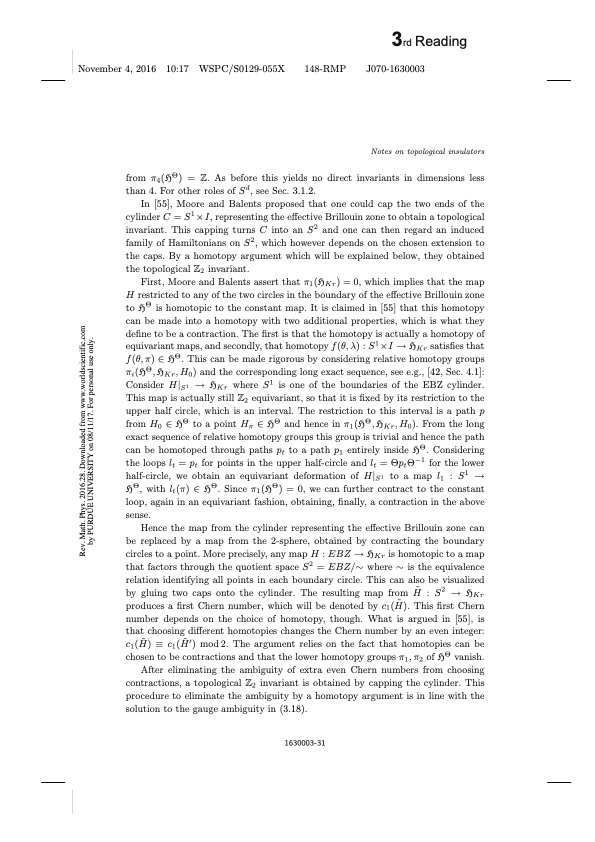
PDF Publication Title:
Text from PDF Page: 031
from π4(HΘ) = Z. As before this yields no direct invariants in dimensions less than 4. For other roles of Sd, see Sec. 3.1.2. In [55], Moore and Balents proposed that one could cap the two ends of the cylinder C = S1 ×I, representing the effective Brillouin zone to obtain a topological invariant. This capping turns C into an S2 and one can then regard an induced family of Hamiltonians on S2, which however depends on the chosen extension to the caps. By a homotopy argument which will be explained below, they obtained the topological Z2 invariant. First, Moore and Balents assert that π1(HKr) = 0, which implies that the map H restricted to any of the two circles in the boundary of the effective Brillouin zone to HΘ is homotopic to the constant map. It is claimed in [55] that this homotopy can be made into a homotopy with two additional properties, which is what they define to be a contraction. The first is that the homotopy is actually a homotopy of equivariant maps, and secondly, that homotopy f(θ,λ) : S1×I → HKr satisfies that f(θ,π) ∈ HΘ. This can be made rigorous by considering relative homotopy groups πi(HΘ,HKr,H0) and the corresponding long exact sequence, see e.g., [42, Sec. 4.1]: Consider H|S1 → HKr where S1 is one of the boundaries of the EBZ cylinder. This map is actually still Z2 equivariant, so that it is fixed by its restriction to the upper half circle, which is an interval. The restriction to this interval is a path p from H0 ∈ HΘ to a point Hπ ∈ HΘ and hence in π1(HΘ,HKr,H0). From the long exact sequence of relative homotopy groups this group is trivial and hence the path can be homotoped through paths pt to a path p1 entirely inside HΘ. Considering the loops lt = pt for points in the upper half-circle and lt = ΘptΘ−1 for the lower half-circle, we obtain an equivariant deformation of H|S1 to a map l1 : S1 → HΘ, with lt(π) ∈ HΘ. Since π1(HΘ) = 0, we can further contract to the constant loop, again in an equivariant fashion, obtaining, finally, a contraction in the above sense. Hence the map from the cylinder representing the effective Brillouin zone can be replaced by a map from the 2-sphere, obtained by contracting the boundary circles to a point. More precisely, any map H : EBZ → HKr is homotopic to a map that factors through the quotient space S2 = EBZ/∼ where ∼ is the equivalence relation identifying all points in each boundary circle. This can also be visualized by gluing two caps onto the cylinder. The resulting map from H ̃ : S2 → HKr produces a first Chern number, which will be denoted by c1(H ̃). This first Chern number depends on the choice of homotopy, though. What is argued in [55], is that choosing different homotopies changes the Chern number by an even integer: c1(H ̃) ≡ c1(H ̃′) mod2. The argument relies on the fact that homotopies can be chosen to be contractions and that the lower homotopy groups π1,π2 of HΘ vanish. After eliminating the ambiguity of extra even Chern numbers from choosing contractions, a topological Z2 invariant is obtained by capping the cylinder. This procedure to eliminate the ambiguity by a homotopy argument is in line with the solution to the gauge ambiguity in (3.18). 1630003-31 Notes on topological insulators Rev. Math. Phys. 2016.28. Downloaded from www.worldscientific.com by PURDUE UNIVERSITY on 08/11/17. For personal use only.PDF Image | Notes on topological insulators

PDF Search Title:
Notes on topological insulatorsOriginal File Name Searched:
RMP.pdfDIY PDF Search: Google It | Yahoo | Bing
Sulfur Deposition on Carbon Nanofibers using Supercritical CO2 Sulfur Deposition on Carbon Nanofibers using Supercritical CO2. Gamma sulfur also known as mother of pearl sulfur and nacreous sulfur... More Info
CO2 Organic Rankine Cycle Experimenter Platform The supercritical CO2 phase change system is both a heat pump and organic rankine cycle which can be used for those purposes and as a supercritical extractor for advanced subcritical and supercritical extraction technology. Uses include producing nanoparticles, precious metal CO2 extraction, lithium battery recycling, and other applications... More Info
| CONTACT TEL: 608-238-6001 Email: greg@infinityturbine.com | RSS | AMP |